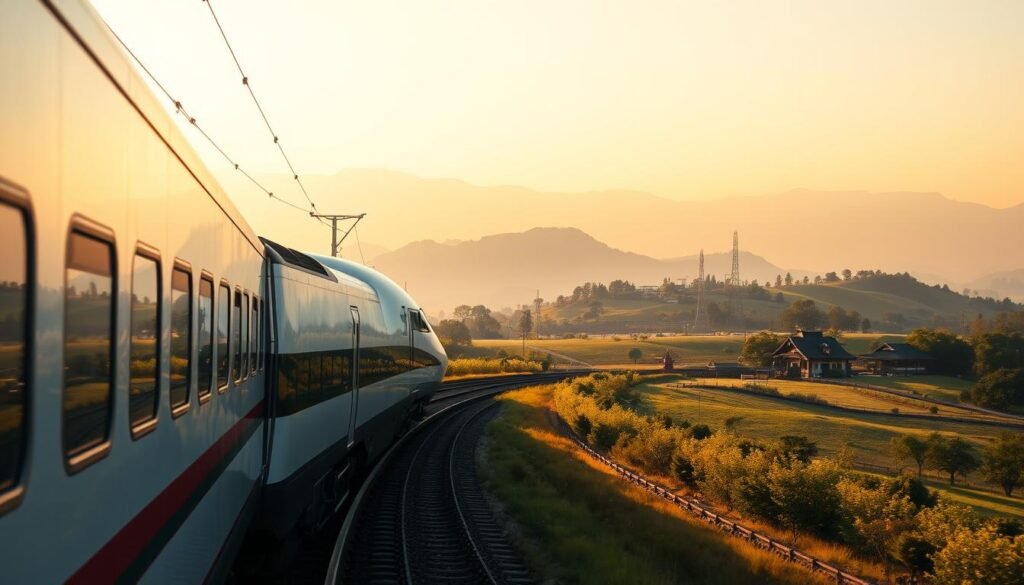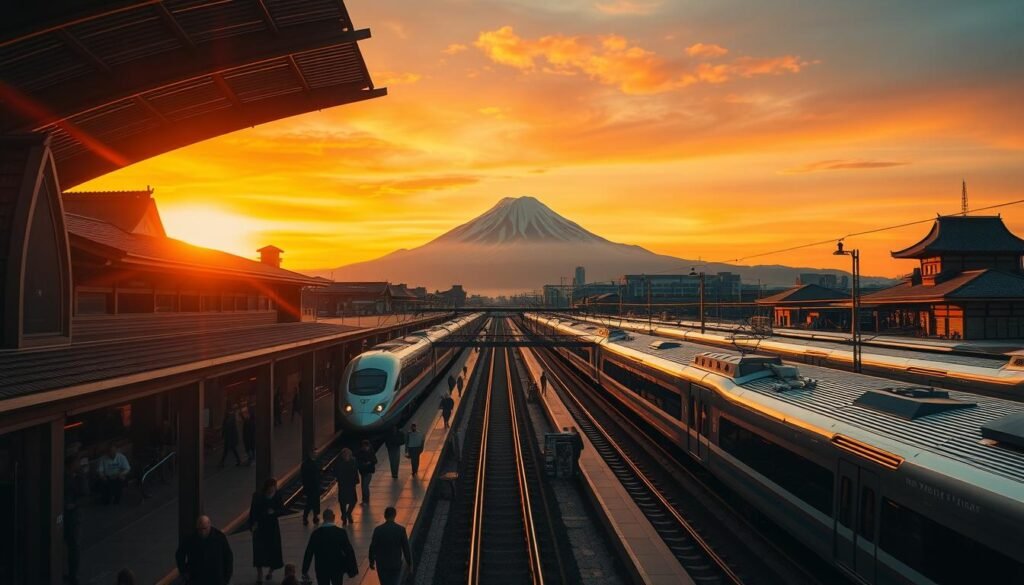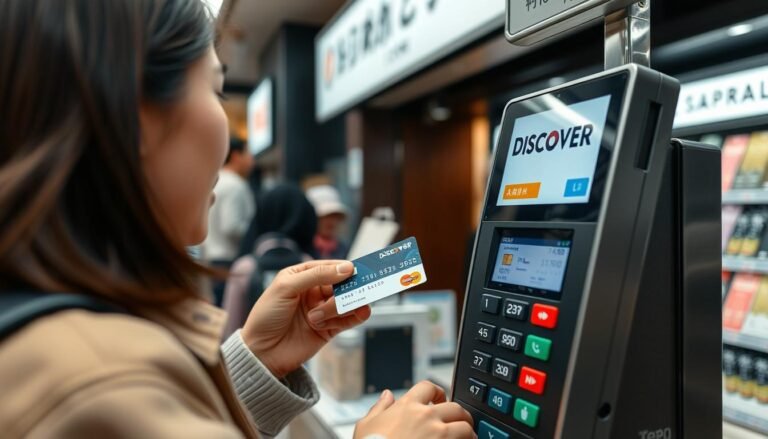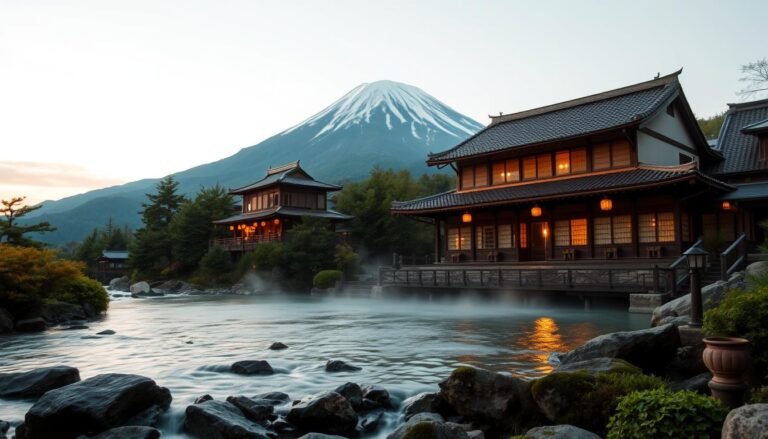Riding the rails in Japan can be thrilling. This guide is for those new to train travel in Japan. It aims to make your journey simple from the start.
Train travel in Japan is known for its speed and convenience. Local trains, subways, and the Shinkansen connect every region. The Japan Rail Pass explained here can save you money. An IC card (like Suica or Pasmo) makes entering stations easy.
Key Takeaways
- Trains in Japan rank high for punctuality and efficiency.
- Local trains, subways, and Shinkansen routes cover wide distances.
- IC cards simplify station entries and exits.
- The Japan Rail Pass explained here is a big value booster.
- Basic familiarity reduces confusion and travel stress.
- Understanding these steps leads to a smooth adventure.
Introduction: Why Japan’s Trains Are Extraordinary for Tourists
Japan’s rail system is known for its speed, cleanliness, and efficiency. Visitors find traveling by train to be an unforgettable experience. The trains run on time, and the amenities make every trip comfortable.
A Glimpse at Speed, Punctuality, and Comfort
Japan’s trains are fast, with Shinkansen trains reaching high speeds. Station clocks are always right, so you know when to arrive. The seats are comfy, and the trains are clean, making travel stress-free.
Local Trains, Subways, and the Famous Shinkansen
There are many types of trains in Japan, from local routes to subways and the famous Shinkansen. These trains travel through beautiful landscapes and cities. They stop often, making it easy to explore the country.
IC Cards and JR Pass: A Quick Overview
IC cards like Suica and Pasmo make traveling easier by eliminating paper tickets. They’re easy to use. JR Pass tips often mention the value of unlimited rides, especially for long trips. Many see this pass as essential for fast travel between cities.
Understanding Japan’s Local Trains and Metros
Local trains and metros are a key part of Japan’s city life. Stations in Tokyo and Osaka link cultural spots, business areas, and quiet neighborhoods. You can ride in modern or vintage trains, each with its own charm.
Exploring lines like Tokyo Metro, Toei Subway, or Osaka Metro is exciting. A single trip can show you hidden gems, like secret eateries and street art. This guide helps you navigate smoothly, making every journey an adventure.
Local trains are also affordable. They make exploring cities easy, with clear signs and regular schedules. Many visitors love these rides to get a feel for local life. Each stop offers new discoveries, making your journey even more special.
Differences Between JR Lines and Private Railways

JR lines cover many areas across Japan, offering a wide network under one family. Private railways like Odakyu or Hankyu focus on certain spots, taking you to famous places. Using japan train travel tips can make your trips quicker and easier.
Some private companies have their own day passes. These might be good for those wanting direct access to certain places. A japan rail pass guide is useful since JR lines work with that pass, making long trips simpler.
What Are Rapid and Express Trains?
Rapid and express trains skip small stations, reaching big hubs quicker. This saves time for tourists in Japan. Always check signs and timetables to find the right coach.
Cost and Coverage Comparisons
JR lines offer wide coverage at fixed rates, great for hopping between cities. Private operators charge based on shorter routes, which is good for local trips. Pick your line based on your budget, destinations, and travel frequency.
All About the Shinkansen (Bullet Trains)
The Shinkansen is a wonder of modern rail engineering. It offers fast travel with quiet cabins. This makes it a favorite for those using japanese trains.
Seats have plenty of legroom. Train staff bow when they arrive, showing great respect.
Major Shinkansen Routes and Travel Times
Key routes connect major cities quickly. The Tokaido line takes you from Tokyo to Osaka in under three hours. The Tohoku line gets you from Tokyo to Aomori fast.
There are different types of trains. Nozomi and Hikari are faster and stop less often than Kodama. Each provides a smooth ride, making the japan rail pass a good choice for travelers.
Why Bullet Trains Are Essential for Tourists
Bullet trains let you see more of Japan in less time. They have plush interiors and depart often. This makes every trip better.
Onboard announcements are soft. Comfort is a big deal, creating a calm and efficient ride.
Ticket Machines and Counters: Step-by-Step Payment Methods

Buying tickets might seem hard at first, but it’s easier with some help. People new to Japan or just taking a short trip feel more confident. They learn how to use the easy-to-follow machines.
Using Cash or Card at the Ticket Machine
The machines have bilingual screens to help with language and prices. Start by picking a fare or entering your destination to see the cost. You can pay with cash or card, making it simpler for those learning about train schedules in Japan.
Buying Tickets at the Counter: What to Expect
Staff at big stations are ready to help visitors who don’t speak Japanese. Just go up to the counter and tell them where you’re going, how many are traveling, and what seats you want. This method is great for both local trips and longer journeys by train in Japan, especially if you like talking to people.
For those planning longer trips, checking a jr pass usage guide is a good idea. Station agents often know some English and can help with seat reservations. They can pick seats that fit your schedule.
IC Cards Explained (Suica, Pasmo, and ICOCA)

IC cards like Suica, Pasmo, and ICOCA make traveling easier. They are easy to recharge and let you quickly pass through ticket gates. This is super helpful in busy stations.
Adding money is simple at machines or stores. Some fare gates accept these cards for the shinkansen, making long trips smooth. You can even buy snacks at kiosks without cash, which is great on busy days.
| Card | Main Areas | Why It’s Handy |
|---|---|---|
| Suica | Tokyo and beyond | Serves multiple lines nationwide |
| Pasmo | Greater Tokyo region | Works on subways and buses |
| ICOCA | Osaka, Kansai area | Key for western Japan travel |
Should You Get the JR Pass? Key Benefits and Considerations

Travelers often wonder if the JR Pass fits their plans. It lets you ride unlimited on many Japan Rail routes, cutting down daily travel costs. It’s perfect for those who want to visit different areas by hopping off at various train stations in japan.
The pass makes long-distance travel easier. With one purchase, you cover many rides, avoiding ticket lines and keeping your budget steady. Some use a japan train route planner to compare prices. Knowing the distances helps figure out if the pass saves money.
It also boosts confidence when exploring japanese train system networks across major cities.
Who Benefits Most from the JR Pass?
Those traveling long distances between Tokyo, Kyoto, and Hiroshima get the most value. Families or groups traveling between different regions save a lot. Frequent Shinkansen rides can be expensive, so the pass is a smart choice.
When It’s Not Worth It
Short trips in just one city might not be worth the pass. Local fares in one area could be cheaper if you don’t take many day trips. Make sure to check your travel plans before deciding to spend wisely.
Navigating Stations: Signs, Platforms, and Boarding Protocol

Japanese train stations welcome visitors with signs in many languages. Clear arrows show the way to the right platform. First-time riders find it easy with overhead boards that list lines in English and Japanese.
Gates are at each entrance for those buying tickets. You can also tap an IC card at the turnstile for quick entry. Ground markings help everyone line up correctly, keeping things orderly.
Maps posted around show exit routes and local line connections. Color-coded signs guide newcomers to their stations.
Japan Rail advises checking signboards before stepping onto subway or bullet train platforms, giving everyone a heads-up on departure times.
Train Etiquette and Seat Reservations
Travelers often notice how quiet and clean each car is when using public transportation in japan. Phones stay on silent, and conversations remain gentle. train schedules in japan seldom change without warning, so it is best to arrive on time. Priority seats go to those in need, reflecting true courtesy on board.
Understanding Reserved vs. Non-Reserved Seats
Passengers on long routes, including the Shinkansen, can choose seats in three categories: Non-Reserved, Reserved, or the premium Green Car. Booking in advance lowers the risk of missing out on a seat. Non-Reserved cars cost less. Yet, Reserved tickets grant reassurance during peak crowds. Each choice supports efficient train travel in japan.
General Manners on Board
Keep your belongings tidy and respect personal space. Pack bags overhead or in dedicated spots. Avoid loud chatter and never block the doors. Eating light snacks is fine, though strong-smelling foods may disturb others. Courteous conduct creates a smooth ride for everyone, and it promotes unity between locals and visitors.
| Seat Type | Key Feature |
|---|---|
| Non-Reserved | First-come, first-served; lower fare |
| Reserved | Guaranteed seat set in advance |
| Green Car | Spacious seats with extra amenities |
Exploring Tokyo, Osaka, and Kyoto by Rail
Many wonder how to navigate train routes in Japan’s big cities. Each city has fast trains, lively stations, and great JR Pass benefits. It’s a fantastic way to dive into city life, especially in Tokyo.
Using Apps Like Google Maps and NAVITIME
Digital tools make planning easier and reduce uncertainty. They show schedules, platforms, and times in real time, aiding smooth transfers. Google Maps and NAVITIME are easy to use, offering station exit info and train car tips.
Color-Coded Lines and Transfers
In Tokyo, Osaka, and Kyoto, main lines have different colors. This makes it easier to find your way. Symbols, maps, and signs guide you to the right platform. Knowing the colors helps with transfers.
| City | Key Lines | Highlight |
|---|---|---|
| Tokyo | Yamanote, Chuo | Iconic stations and major shopping hubs |
| Osaka | Loop Line, Midosuji | Popular downtown areas and theme parks |
| Kyoto | JR Sagano, Karasuma | Historic temples and charming districts |
Avoiding Common Mistakes and Travel Pitfalls
Travelers often miss small sign changes and confuse local and rapid trains. This mistake can lead to unexpected station transfers. It’s crucial to stay alert to station announcements in both big cities and small towns. Missing these announcements can mess up your plans.
Smart planning helps avoid last-minute confusion. Always check departure boards for seat class details, especially when using a shinkansen bullet train guide. Look out for signs that show your platform. And, prepare ahead with rail travel tips in japan. If you miss your train, remember that trains usually run often.
Glance at this reference chart for common mistakes:
| Pitfall | Quick Fix |
|---|---|
| Misreading signboards | Scan local language plus English displays |
| Boarding wrong car | Double-check seat class or train type |
| Forgetting small transfers | Use route-planning apps |
Using local trains in japan needs caution. Always trust official indicators and station staff when you’re unsure. Being flexible with your travel plans can make your journey smoother.
Essential Tips for Stress-Free Train Travel
Traveling by train can be smooth with the right approach. A bit of planning is key when using public transportation in Japan. Knowing about crowds and baggage needs helps a lot. This simple tip ensures a relaxing trip.
Peak Hours vs. Off-Peak Travel
Big city lines get very busy in the morning and late afternoon. Some people like to travel in the middle of the day to avoid crowds. Quieter times let you enjoy the scenery more.
Smaller stations have fewer people, making your trip more comfortable. This is especially important for first-time visitors. Being flexible with your travel time helps you avoid busy periods and enjoy your journey more. Traveling during peak hours can be overwhelming if you’re looking for a calm trip.
Choosing Ideal Luggage Storage Options
Some trains have overhead racks for small bags. Coin lockers are great for medium-sized suitcases at many major stations. These keep the walkways clear.
Large stations are better for busy travelers because they have clearer signs. If you plan to move around a lot, consider a compact suitcase.
Organized packing saves effort and keeps you relaxed on any trip. Overpacking can make busy rides tight. Handling big bags can cause unnecessary stress.
Why “how to use trains in Japan” Matters for Your Trip
Traveling by train is a great way to see Japan’s best spots and experience local culture. Many newcomers feel unsure about how to use the trains. But, learning basic tips can make your journey easier.
Key Insights for First-Time Visitors
A good japan railway guide for tourists can lead you to historic sites and lively cities. At first, station layouts might seem confusing. But, paying attention to signs and colors helps you find your way.
Maps and apps are useful, but don’t forget small details like exit numbers and platform gates. This way, you can stay on track without getting lost.
Simplifying Your Travel Logistics
Following simple tips for train travel in Japan can save you a lot of time. Planning your ticket options or using IC cards makes transfers smoother. This lets you enjoy more of Japan’s culture and delicious food.
| Must-Do Step | Reason | Outcome |
|---|---|---|
| Check Train Lines Early | Create a clear route | Less confusion |
| Buy Tickets in Advance | Secure better seating | Avoid last-minute stress |
| Have a Backup Plan | Unforeseen delays | Stay flexible |
Planning a Train-Centric Itinerary
Creating a train-focused plan can bring together the best of each region. It combines scenic views, local foods, and famous sites into one journey. Routes often highlight cultural treasures, like Himeji Castle and Hiroshima’s Peace Memorial.
Planning a trip with the best trains in japan for tourists is easy with a good guide. You might visit Mt. Fuji for stunning views or explore Kyoto’s temples. Less crowded lines reveal hidden gems, and bullet trains link these spots efficiently.
Japan’s transport system connects big cities with heritage towns. A well-planned itinerary helps you use your JR Pass wisely and enjoy local snacks. Seats on popular routes fill up fast, so book early.
Here are some route ideas:
| Destination | Famous Spot | Rail Line | Approx. Travel Time |
|---|---|---|---|
| Tokyo | Skytree | JR Yamanote | 15 min from Tokyo Station |
| Mt. Fuji | Fujisan Station | Fujikyu Railway | 2 hr from Shinjuku |
| Hiroshima | Peace Memorial Park | Sanyo Shinkansen | 4 hr from Tokyo |
| Himeji | Himeji Castle | Sanyo Shinkansen | 3 hr from Tokyo |
Conclusion
Japanese trains open a new world for curious visitors. This guide shows the speed and comfort of traveling by train. Each part of your trip can be more rewarding with good planning and seat choices.
The experience combines reliability with local charm. You’ll see city skylines and countryside in one journey. Stations are vibrant, showing off regional eateries, and service is always polite.
Getting tickets and knowing seat etiquette becomes easy once you start. Travel tips include packing light and watching for station signs. Bring an adventure spirit and connect distant places in one journey.
Riding the rails can save money, spark conversations, and clear your mind for new experiences. Enjoy the simple joy of Japanese train travel and make lasting memories.






